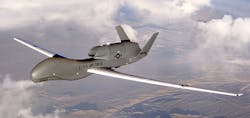Northrop Grumman refines radar software for Global Hawk surveillance UAS
Officials of the U.S. Air Force Life Cycle Management Center at Hanscom Air Force Base, Mass., have announced a $17 million contract modification to the Northrop Grumman Aerospace Systems segment in El Segundo, Calif., for radar software corrections for the Multi-Platform Radar Technology Insertion Program (MP-RTIP).
The Air Force's MP-RTIP program is developing a modular, active electronically scanned array (AESA) radar system scalable for the Global Hawk UAS and the Air Force Joint Surveillance Target Attack Radar System (Joint STARS).
The Raytheon Co. Space and Airborne Systems segment in El Segundo, Calif., is a primary subcontractor on the program MP-RTIP, and is in charge of the radar system's hardware development.
The MP-RTIP system is being created from previously developed Northrop-Grumman radar technology, including the Air Force's E-8 Joint STARS aircraft and the existing Global Hawk radar system.
Related: RQ-4 Global Hawk unmanned aircraft moving toward modernization
The block 40 Global Hawk is larger than the original Global Hawk models, with a longer fuselage, larger payload capacity, larger electrical output, and longer wingspan.
The MP-RTIP radar that Northrop Grumman and Raytheon are developing will be able to track slow-moving ground vehicles and low-flying cruise missiles. Compared with existing ground-surveillance radar systems, the MP-RTIP will have enhanced resolution and will be able to collect ground moving target indicator imagery and synthetic aperture radar still images simultaneously.
Northrop Grumman and Raytheon started developing the MP-RTIP radar system in late 2000, and company experts have finished the system's basic design, development, testing, and systems integration.
The Block 40 configuration of the RQ-4 Global Hawk first flew in late 2009. Northrop Grumman began integrating the MP-RTIP radar aboard the Global Hawk Block 40 in 2012.
On this contract modification Northrop Grumman will do the work in El Segundo, Calif., and should be finished in November 2016. For more information contact Northrop Grumman Aerospace Systems online at www.northropgrumman.com, or the Air Force Life Cycle Management Center at www.wpafb.af.mil/aflcmc.
About the Author
John Keller
Editor-in-Chief
John Keller is the Editor-in-Chief, Military & Aerospace Electronics Magazine--provides extensive coverage and analysis of enabling electronics and optoelectronic technologies in military, space and commercial aviation applications. John has been a member of the Military & Aerospace Electronics staff since 1989 and chief editor since 1995.
